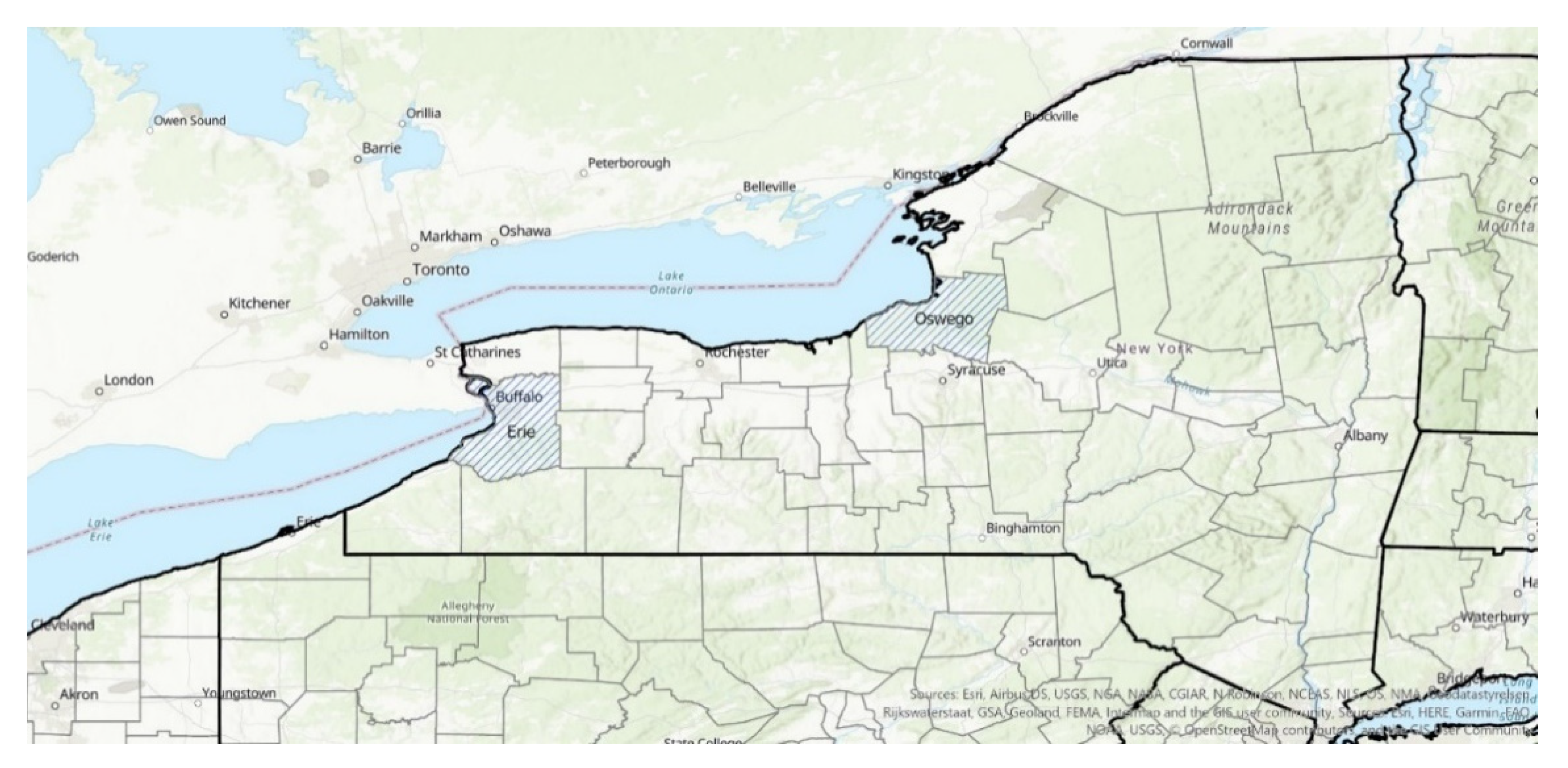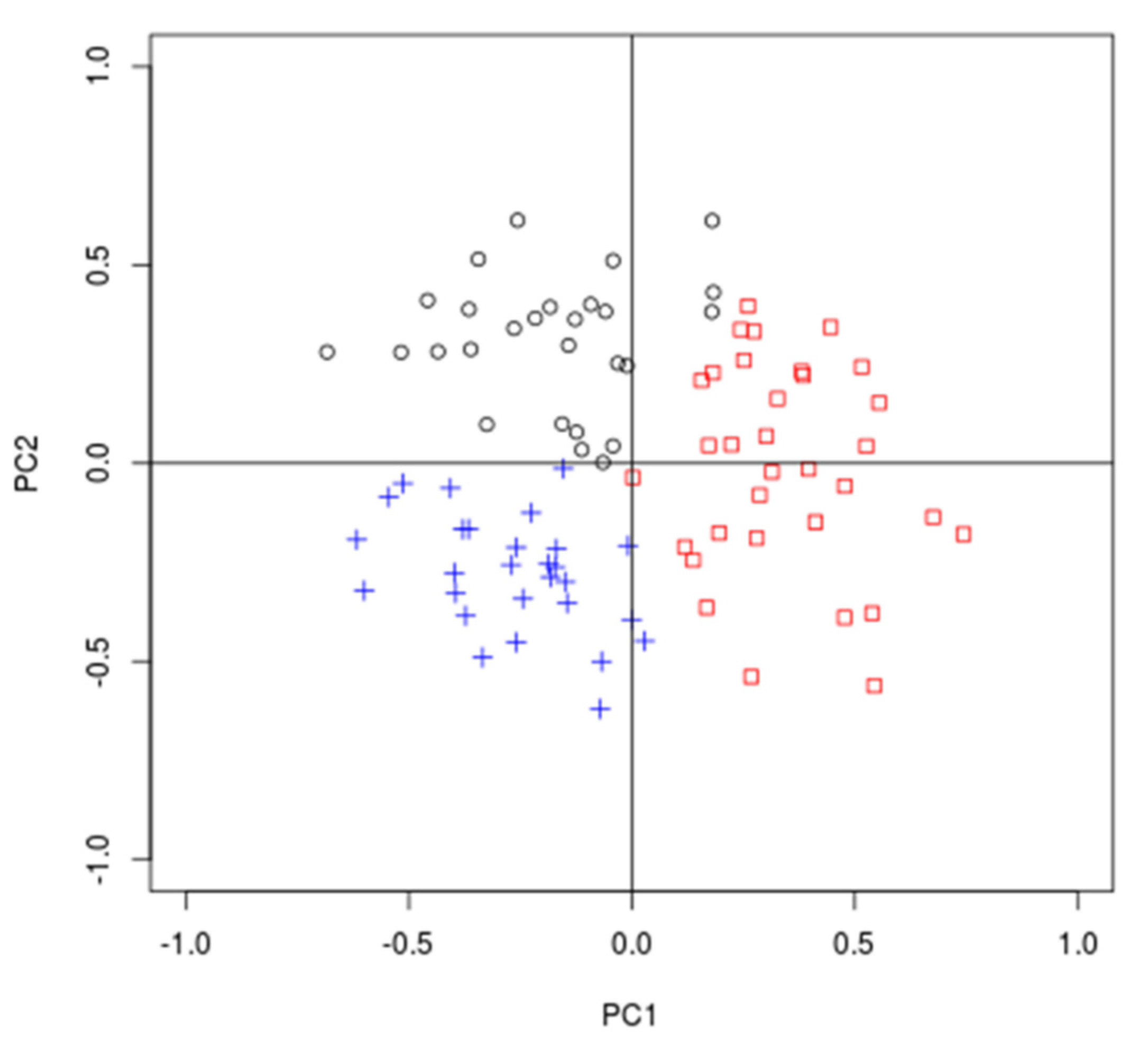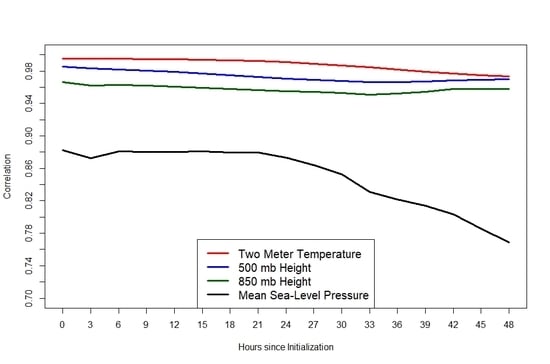An Updated Synoptic Climatology of Lake Erie and Lake Ontario Heavy Lake-Effect Snow Events
Abstract
:1. Introduction
- An extratropical cyclone over the Canadian Maritimes/New England area,
- An extratropical anticyclone present in the central/southern Great Plains,
- A large-scale upper tropospheric trough centered near the Hudson Bay.
2. Experimental Methods
2.1. Data
2.2. Statistical Analysis
2.3. Numerical Modeling and Case Selection
3. Results and Discussion
3.1. Composite Analysis
3.1.1. Cluster 1
3.1.2. Cluster 2
3.1.3. Cluster 3
3.1.4. Cluster Differences
3.2. WRF Simulations
3.2.1. Case 1: 27 December 2013
3.2.2. Case 2: 2 December 2010
3.2.3. Case 3: 31 January 2007
4. Conclusions
- Cluster 1—A dipole structure featuring a stationary low-pressure anomaly off the northeast U.S coast and a high-pressure anomaly located over the south central/southeast U.S that originates from the northern Great Plains. Both pressure systems strengthened throughout the study period. The spatial setup of this dipole led to strong west-southwesterly winds that flowed across the long axes of both lakes.
- Cluster 2—A dynamic dipole featuring cyclogenesis over the Great Lakes following an Alberta Clipper track, and a higher central pressure than any of other the low-pressure systems identified [45]. The high-pressure anomaly features similar spatial structure and evolution to other clusters but is weaker. The spatial structure of the dipole initially results in pure westerly winds over the two lakes. Westerly flow over Lake Erie has been associated with widespread coverage band structure, and events grouped in this cluster exhibited wide coverage characteristics more frequently than any cluster. Although the dipole was weaker, the pressure gradient was of a similar magnitude to Cluster 1, which resulted in similar wind speeds.
- Cluster 3—A dipole structure similar to Cluster 1 with a few unique distinctions. The dipole structure overall was weaker, consisting of higher central pressure for the low-pressure anomaly and lower pressure for the high-pressure anomaly. The structure of each of the pressure systems differed as well, as the high-pressure anomaly was more elongated and positioned closer to the two lakes. These observations ultimately led to a less conducive LES environment featuring higher surface pressure and slightly slower winds.
Author Contributions
Funding
Acknowledgments
Conflicts of Interest
References
- Hill, J.D. Snow Squalls in the Lee of Lakes Erie and Ontario; NOAA Tech. Memo; NWS ER-43; 1971; p. 20, [NTIS COM-72-00959]. [Google Scholar]
- Orlanski, I. A rational subdivision of scales for atmospheric processes. Bull. Am. Meteorol. Soc. 1975, 56, 527–530. [Google Scholar]
- Notaro, M.; Zarrin, A.; Vavrus, S.; Bennington, V. Simulation of heavy lake-effect snowstorms across the great lakes basin by RegCM4: Synoptic climatology and variability. Mon. Weather Rev. 2013, 141, 1990–2014. [Google Scholar] [CrossRef]
- Wiggin, B.L. Great Snows of the Great Lakes. Weatherwise 1950, 3, 123–126. [Google Scholar] [CrossRef]
- Niziol, T.A. Operational Forecasting of Lake Effect Snowfall in Western and Central New York. Weather Forecast. 1987, 2, 310–321. [Google Scholar] [CrossRef]
- Steiger, S.M.; Schrom, R.; Stamm, A.; Ruth, D.; Jaszka, K.; Kress, T.; Rathbun, B.; Frame, J.; Wurman, J.; Kosiba, K. Circulations, bounded weak echo regions, and horizontal vortices observed within long-lake-axis-parallel-lake-effect storms by the doppler on wheels. Mon. Weather Rev. 2013, 141, 2821–2840. [Google Scholar] [CrossRef]
- Veals, P.G.; James Steenburgh, W. Climatological characteristics and orographic enhancement of lake-effect precipitation east of Lake Ontario and over the Tug Hill Plateau. Mon. Weather Rev. 2015, 143, 3591–3609. [Google Scholar] [CrossRef]
- U.S. Census Bureau. 2020: 2019 Census Data. Available online: https://www.census.gov/ (accessed on 21 July 2020).
- Changnon, S.A. How a severe winter impacts on individuals. Bull. Am. Meteorol. Soc. 1979, 60, 110–114. [Google Scholar] [CrossRef] [Green Version]
- Schmidlin, T.W. Impacts of severe winter weather during December 1989 in the Lake Erie Snowbelt. J. Clim. 1993, 6, 759–767. [Google Scholar] [CrossRef] [Green Version]
- Kunkel, K.E.; Westcott, N.E.; Kristovich, D.A.R. Assessment of Potential Effects of Climate Change on Heavy Lake-Effect Snowstorms Near Lake Erie. J. Great Lakes Res. 2002, 28, 521–536. [Google Scholar] [CrossRef]
- Mason, L.A.; Riseng, C.M.; Gronewold, A.D.; Rutherford, E.S.; Wang, J.; Clites, A.; Smith, S.D.P.; McIntyre, P.B. Fine-scale spatial variation in ice cover and surface temperature trends across the surface of the Laurentian Great Lakes. Clim. Chang. 2016, 138, 71–83. [Google Scholar] [CrossRef]
- Baijnath-Rodino, J.A.; Duguay, C.R.; LeDrew, E. Climatological trends of snowfall over the Laurentian Great Lakes basin. Int. J. Climatol. 2018, 38, 3942–3962. [Google Scholar] [CrossRef]
- Niziol, T.A.; Synder, W.R.; Waldstreicher, J.S. Winter Weather Forecasting throughout the Eastern United States. Part IV: Lake Effect Snow. Weather Forecast. 1995, 10, 61–77. [Google Scholar] [CrossRef] [Green Version]
- Kristovich, D.A.R.; Laird, N.F. Observations of widespread lake-effect cloudiness: Influences of upwind conditions and lake surface temperatures. Weather Forecast. 1998, 13, 811–821. [Google Scholar] [CrossRef]
- Kristovich, D.A.R.; Clark, R.D.; Frame, J.; Geerts, B.; Knupp, K.R.; Kosiba, K.; Laird, N.F.; Metz, N.D.; Minder, J.R.; Sikora, T.D.; et al. The Ontario Winter Lake-Effect Systems field campaign: Scientific and educational adventures to further our knowledge and prediction of lake-effect storms. Bull. Am. Meteorol. Soc. 2017, 98, 315–332. [Google Scholar] [CrossRef]
- Byrd, G.P.; Anstett, R.A.; Heim, J.E.; Usinski, D.M. Mobile sounding observations of lake-effect snowbands in western and central New York. Mon. Weather Rev. 1991, 119, 2323–2332. [Google Scholar] [CrossRef] [Green Version]
- Cordeira, J.M.; Laird, N.F. The influence of ice cover on two lake-effect snow events over Lake Erie. Mon. Weather Rev. 2008, 136, 2747–2763. [Google Scholar] [CrossRef] [Green Version]
- Vavrus, S.; Notaro, M.; Zarrin, A. The role of ice cover in heavy lake-effect snowstorms over the great lakes basin as simulated by RegCM4. Mon. Weather Rev. 2013, 141, 148–165. [Google Scholar] [CrossRef]
- Campbell, L.S.; Steenburgh, W.J.; Veals, P.G.; Letcher, T.W.; Minder, J.R. Lake-effect mode and precipitation enhancement over the Tug Hill Plateau during OWLeS IOP2b. Mon. Weather Rev. 2016, 144, 1729–1748. [Google Scholar] [CrossRef]
- Rodriguez, Y.; Kristovich, D.A.R.; Hjelmfelt, M.R. Lake-to-lake cloud bands: Frequencies and locations. Mon. Weather Rev. 2007, 135, 4202–4213. [Google Scholar] [CrossRef]
- Steiger, S.M.; Hamilton, R.; Keeler, J.; Orville, R.E. Lake-effect thunderstorms in the lower great lakes. J. Appl. Meteorol. Clim. 2009, 48, 889–902. [Google Scholar] [CrossRef] [Green Version]
- Ellis, A.W.; Leathers, D.J. A synoptic climatological approach to the analysis of lake-effect snowfall: Potential forecasting applications. Weather Forecast. 1996, 11, 216–229. [Google Scholar] [CrossRef] [Green Version]
- Liu, A.Q.; Moore, G.W.K. Lake-effect snowstorms over southern Ontario, Canada, and their associated synoptic-scale environment. Mon. Weather Rev. 2004, 132, 2595–2609. [Google Scholar] [CrossRef]
- Suriano, Z.J.; Leathers, D.J. Synoptic climatology of lake-effect snowfall conditions in the eastern Great Lakes region. Int. J. Clim. 2017, 37, 4377–4389. [Google Scholar] [CrossRef]
- Storm Events Database. Available online: https://www.ncdc.noaa.gov/stormevents/ (accessed on 4 May 2017).
- National Weather Service Instruction 10-1605. Available online: http://www.nws.noaa.gov/directives/sym/pd01016005curr.pdf (accessed on 23 August 2017).
- Mesinger, F. North American Regional Reanalysis. Bull. Am. Meteorol. Soc. 2006, 87, 343–360. [Google Scholar] [CrossRef] [Green Version]
- Mercer, A.E.; Shafer, C.M.; Doswell, C.A.; Leslie, L.M.; Richman, M.B. Synoptic composites of tornadic and nontornadic outbreaks. Mon. Weather Rev. 2012, 140, 2590–2608. [Google Scholar] [CrossRef] [Green Version]
- Wilks, D.S. Statistical Methods in the Atmospheric Sciences; Academic Press: San Diego, CA, USA, 2011; p. 614. [Google Scholar]
- Rousseeuw, P.J. Silhouettes: A graphical aid to the interpretation and validation for cluster analysis. J. Comput. Appl. Math. 1987, 20, 53–65. [Google Scholar] [CrossRef] [Green Version]
- Skamarock, W.C.; Klemp, J.B.; Dudhia, J.; Gill, D.O.; Barker, D.M.; Wang, W.; Powers, J.G. A Description of the Advanced Research WRF Version 3. NCAR Technical Note-475+ STR. University; Corporation for Atmospheric Research: Boulder, CO, USA, 2008. [Google Scholar] [CrossRef]
- Shi, J.J.; Tao, W.K.; Matsui, T.; Cifelli, R.; Hou, A.; Lang, S.; Tokay, A.; Wang, N.Y.; Peters-Lidard, C.; Skofronick-Jackson, G.; et al. WRF simulations of the 20–22 January 2007 snow events over eastern Canada: Comparison with in situ and satellite observations. J. Appl. Meteorol. Clim. 2010, 49, 2246–2266. [Google Scholar] [CrossRef] [Green Version]
- Wright, D.M.; Posselt, D.J.; Steiner, A.L. Sensitivity of lake-effect snowfall to lake ice cover and temperature in the great lakes region. Mon. Weather Rev. 2013, 141, 670–689. [Google Scholar] [CrossRef] [Green Version]
- Mallard, M.S.; Nolte, C.G.; Bullock, O.R.; Spero, T.L.; Gula, J. Using a coupled lake model with WRF for dynamical downscaling. J. Geophys. Res. Atmos. 2014, 119, 7193–7208. [Google Scholar] [CrossRef]
- Oleson, K.W. Technical description of version 4.5 of the Community Land Model (CLM); NCAR Tech. Note NCAR/TN-5031STR; National Center for Atmospheric Research: Boulder, CO, USA, 2013; p. 422. [Google Scholar] [CrossRef]
- Wan, Z.; Zhang, Y.; Zhang, Q.; Li, Z.-L. Validation of the land-surface temperature products retrieved from moderate resolution imaging spectroradiometer data. Remote Sens. Environ. 2002, 83, 163–180. [Google Scholar] [CrossRef]
- Tao, W.-K.; Simpson, J. Goddard cumulus ensemble model. Part I: Model description. Terr. Atmos. Ocean. Sci. 1993, 4, 35–72. [Google Scholar] [CrossRef]
- Mellor, G.L.; Yamada, T. Development of a turbulence closure model for geophysical fluid problems. Rev. Geophys. 1982, 20, 851–875. [Google Scholar] [CrossRef] [Green Version]
- Ek, M.B.; Mitchell, K.E.; Lin, Y.; Rogers, E.; Grunmann, P.; Koren, V.; Gayno, G.; Tarpley, J.D. Implementation of Noah land surface model advances in the National Centers for Environmental Prediction operational mesoscale Eta model. J. Geophys. Res. Atmos. 2003, 108, 1–16. [Google Scholar] [CrossRef]
- Dudhia, J. Numerical study of convection observed during the Winter Monsoon Experiment using a mesoscale two- dimensional model. J. Atmos. Sci. 1989, 46, 3077–3107. [Google Scholar] [CrossRef]
- Mlawer, E.J.; Taubman, S.J.; Brown, P.D.; Iacono, M.J.; Clough, S.A. Radiative transfer for inhomogeneous atmospheres: RRTM, a validated correlated-k model for the longwave. J. Geophys. Res. 1997, 102, 16663–16682. [Google Scholar] [CrossRef] [Green Version]
- Kain, J.S.; Fritsch, J.M. The role of the convective ‘‘trigger function’’ in numerical prediction of mesoscale convective systems. Meteorol. Atmos. Phys. 1993, 49, 93–106. [Google Scholar] [CrossRef]
- Janjic, Z.I. The surface layer in the NCEP Eta Model. In Eleventh Conference on Numerical Weather Prediction, Norfolk VA, USA, 19–23 August 1996; American Meteorological Society: Boston, MA, USA, 1996; pp. 354–355. [Google Scholar]
- Mercer, A.E.; Richman, M.B. Statistical differences of quasigeostrophic variables, stability, and moisture profiles in North American storm tracks. Mon. Weather Rev. 2007, 135, 2312–2338. [Google Scholar] [CrossRef] [Green Version]
- Sousounis, P.J. Lake-Effect Storms. In Encyclopedia of Atmospheric Sciences; Academic Press: Cambridge, MA, USA, 2001; pp. 1104–1115. [Google Scholar]
- Brown, R.A.; Niziol, T.A.; Donaldson, N.R.; Joe, P.I.; Wood, V.T. Improved detection using negative elevation angles for mountaintop WSR-88Ds. Part III: Simulations of shallow convective activity over and around Lake Ontario. Weather Forecast. 2007, 22, 839–852. [Google Scholar] [CrossRef]
- Holroyd, E.W. Lake-effect cloud bands as seen from weather satellites. J. Atmos. Sci. 1971, 28, 1165–1170. [Google Scholar] [CrossRef] [Green Version]
- Cooper, K.A.; Hjelmfelt, M.R.; Derickson, R.G.; Kristovich, D.A.R.; Laird, N.F. Numerical simulation of transitions in boundary layer convective structures in a lake-effect snow event. Mon. Weather Rev. 2000, 128, 3283–3295. [Google Scholar] [CrossRef]
- Hartnett, J.J.; Collins, J.M.; Baxter, M.A.; Chambers, D.P. Spatiotemporal snowfall trends in central New York. J. Appl. Meteorol. Clim. 2014, 53, 2685–2697. [Google Scholar] [CrossRef]















| PC 2 | PC 3 | PC 4 | PC 5 | PC 6 | |
|---|---|---|---|---|---|
| Individual Variance Explained | 9.36% | 7.56% | 6.11% | 5.40% | 4.31% |
| Cumulative Variance Explained | 20.3% | 27.86% | 33.97% | 39.37% | 43.68% |
| Silhouette Coefficient using Three Clusters | 0.40 | 0.29 | 0.23 | 0.18 | 0.15 |
| Cluster 1 | Cluster 2 | Cluster 3 | |
|---|---|---|---|
| Event Start | 2013-12-26 16:00 | 2010-12-01 15:00 | 2007-01-31 06:00 |
| Event End | 2013-12-27 11:00 | 2010-12-02 19:00 | 2007-01-31 16:00 |
| Duration | 19 h | 28 h | 10 h |
| Source | Lake Ontario | Lake Erie | Lakes Erie and Ontario |
| Band Type | LLAP | LLAP | LLAP |
| Highest Snowfall Total Recorded (in) | 20 | 42 | 35 |
| WRF Simulation Duration | 48 h | 48 h | 48 h |
| Parameterization | Scheme/Model |
|---|---|
| Microphysics | Goddard microphysics scheme [38] |
| Planetary Boundary Layer | Mellor–Yamada–Janjic [39] |
| Land Surface Model | Noah Land Surface Model [40] |
| Shortwave Radiation Physics | Dudhia shortwave scheme [41] |
| Longwave Radiation Physics | Rapid Radiative Transfer Model [42] |
| Cumulus Scheme | Kain–Fritsch * [43] |
| Surface Layer Physics | Eta similarity [44] |
© 2020 by the authors. Licensee MDPI, Basel, Switzerland. This article is an open access article distributed under the terms and conditions of the Creative Commons Attribution (CC BY) license (http://creativecommons.org/licenses/by/4.0/).
Share and Cite
Wiley, J.; Mercer, A. An Updated Synoptic Climatology of Lake Erie and Lake Ontario Heavy Lake-Effect Snow Events. Atmosphere 2020, 11, 872. https://doi.org/10.3390/atmos11080872
Wiley J, Mercer A. An Updated Synoptic Climatology of Lake Erie and Lake Ontario Heavy Lake-Effect Snow Events. Atmosphere. 2020; 11(8):872. https://doi.org/10.3390/atmos11080872
Chicago/Turabian StyleWiley, Jake, and Andrew Mercer. 2020. "An Updated Synoptic Climatology of Lake Erie and Lake Ontario Heavy Lake-Effect Snow Events" Atmosphere 11, no. 8: 872. https://doi.org/10.3390/atmos11080872
APA StyleWiley, J., & Mercer, A. (2020). An Updated Synoptic Climatology of Lake Erie and Lake Ontario Heavy Lake-Effect Snow Events. Atmosphere, 11(8), 872. https://doi.org/10.3390/atmos11080872






